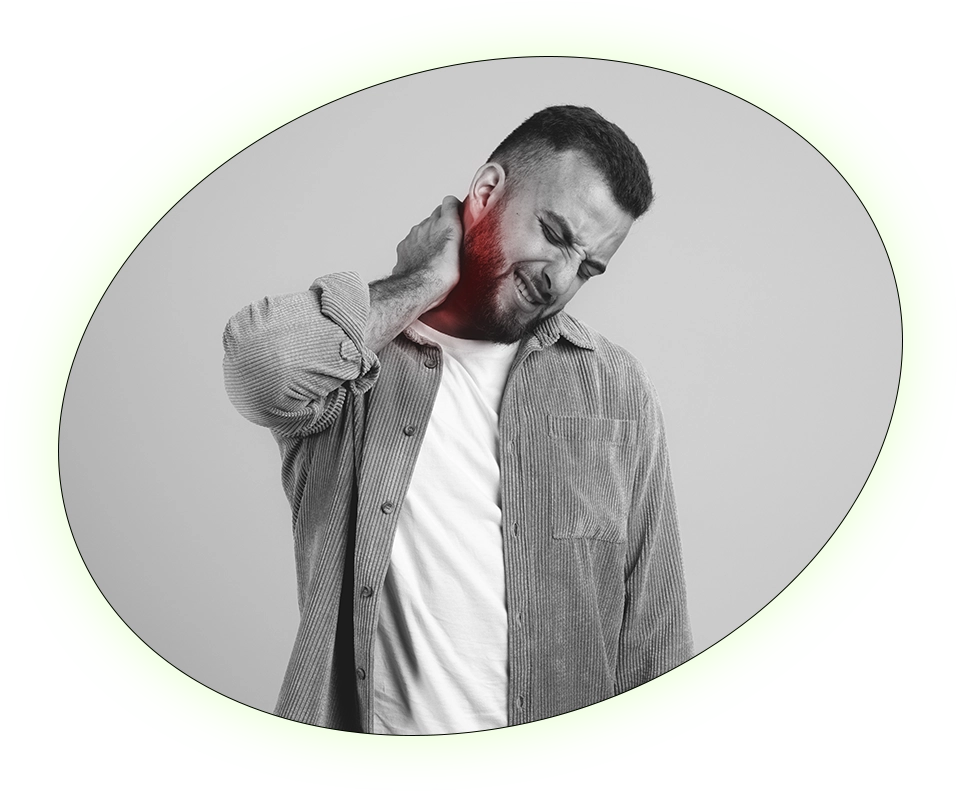Head and Neck Pain
Head and neck pain can sneak into your life, making simple movements difficult and affecting your focus, posture, and overall well-being. Whether it’s a dull ache, sharp pain, or chronic stiffness, this discomfort can limit your mobility and reduce your quality of life.

Pain in the head and neck area can result from muscle strain, poor posture, injuries, or nerve-related conditions. It often develops due to daily habits—sitting at a desk, using a smartphone, or sleeping in the wrong position. In some cases, it may indicate more serious conditions like migraines or nerve compression.
Head and neck pain often stem from poor posture and prolonged screen time, leading to muscle strain, commonly known as “tech neck.” Injuries like whiplash from accidents or sports can also cause sudden and severe discomfort, affecting mobility and daily activities.
Tension Headaches & Migraines: Muscle tightness causing persistent head and neck pain.
Pinched Nerves & Spinal Misalignment: Nerve irritation causing radiating discomfort.
Sleeping in the wrong position or using inadequate pillow support can strain the neck, leading to stiffness and discomfort that affects daily movement.
Ignoring head and neck pain can lead to long-term spinal issues, chronic headaches, and even nerve damage. Understanding its root causes is essential for finding relief and preventing further complications.
Head and neck pain can result from stress, poor posture, or nerve compression, often leading to headaches and discomfort. Proper posture, sleep support, and small daily changes can help prevent long-term issues.

Pain can be temporary due to stress or injuries or long-term from posture-related issues.

Stiff neck muscles often contribute to migraines and tension headaches.

Slouching at a desk or hunching over devices strains the neck muscles.

Pinched nerves in the neck can lead to arm numbness and tingling.

Unsupported sleeping posture can worsen pain over time.

Small daily changes can prevent long-term damage and improve posture.
Pain in this area often results from lifestyle habits or medical conditions, including:

Extended phone or computer use strains the neck muscles.

Sudden jerks, falls, or car accidents causing soft tissue damage.

Stress-induced muscle tension creating pain in the head and neck.

Herniated discs and spinal misalignment pressing on nerves.

How Head and Neck Pain Disrupts Daily Life
Persistent discomfort in the head and neck affects your ability to concentrate, sleep, and move freely. Addressing it early prevents complications.
Don’t let head and neck pain hold you back.
Simple Ways to Relieve & Prevent Pain.

Adjust desk height, chair support, and screen positioning.

Improve flexibility and reduce muscle tension.

Meditation and deep breathing techniques to ease tension headaches.

Heat therapy, self-massage, and proper pillow support.

When pain persists, seeking expert assessment is key.
Here are some of the questions that we are asked most frequently at Total Spine and Wellness
Regenerative medicine aims to replace damaged tissue or organs caused by factors like age, disease, trauma, or congenital issues, as opposed to focusing solely on symptom management. This is achieved through the use of tissue engineering, cellular therapies, medical devices, and artificial organs.
By combining these approaches, we can enhance our body’s natural healing process where it is most needed. Regenerative medicine brings together experts from various specialties who wish to be on the cutting edge of medicine.
When our bodies are injured or affected by disease, they possess an innate ability to heal and defend themselves. What if we could harness this inherent power and accelerate the healing process in a clinically relevant manner? What if we could aid the body in healing more effectively?
The promising field of regenerative medicine strives to restore the structure and function of damaged tissues and organs. It also aims to develop solutions for organs that have sustained permanent damage. Ultimately, the goal of regenerative medicine is to create transformative healthcare solutions that could potentially help injuries and diseases that were previously deemed untreatable.
Stem cells are undifferentiated cells in our bodies that have the remarkable ability to develop into various types of specialized cells. They can divide and renew themselves to form more stem cells or differentiate into specific cell types, such as muscle, nerve, or blood cells. Stem cells play a crucial role in the development, growth, and repair of tissues and organs in our bodies. They hold great potential for medical research and regenerative medicine, as they may be used to treat a wide range of diseases and injuries.
Stem cells have the remarkable ability to develop into different cell types in the body and can also repair damaged tissues. When introduced into a specific area, they can promote healing through various mechanisms. Stem cells can differentiate into the desired cell type, replacing damaged cells directly. They can also secrete growth factors and proteins that stimulate the surrounding cells to regenerate and repair themselves. Additionally, stem cells can modulate the immune response and reduce inflammation, creating a more favorable environment for healing. These combined effects make stem cells a valuable tool for treating degenerative conditions.
Mesenchymal stem cells (MSCs) are a promising source for the treatment of OA due to their multipotency for differentiation into chondrocytes and their ability to modulate the immune system.
These surgical procedures are considered part of a physician’s practice of medicine, allowing both the physician and patient to freely consider their preferred treatment options. While the FDA does provide guidelines for the treatment and manipulation of a patient’s own tissues, Total Spine adheres to these guidelines by offering same-day treatment using the patient’s unaltered cells, which are inserted during the procedure.
Not everyone is a good candidate for stem cell treatment. We offer a complimentary consultation and imaging review to determine if someone is likely to benefit from our treatments. If the severity of the condition is too great and a successful outcome is not likely, the patient will be told that in consultation.
We are a team of highly specialized spine surgeons dedicated to pioneering the future of spine care.